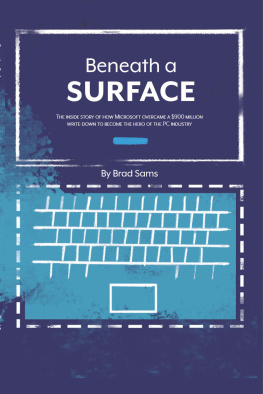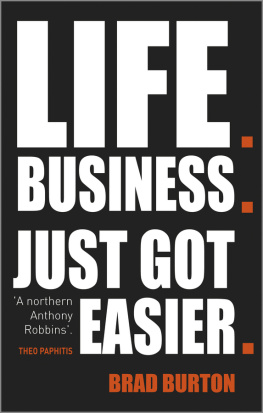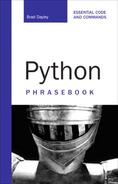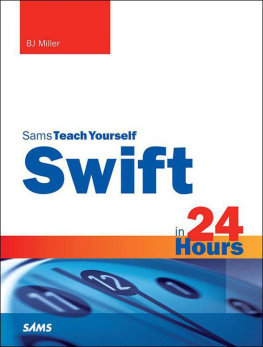Brad Sams - Beneath A Surface
Here you can read online Brad Sams - Beneath A Surface full text of the book (entire story) in english for free. Download pdf and epub, get meaning, cover and reviews about this ebook. year: 2018, publisher: Independently published, genre: Non-fiction / History. Description of the work, (preface) as well as reviews are available. Best literature library LitArk.com created for fans of good reading and offers a wide selection of genres:
Romance novel
Science fiction
Adventure
Detective
Science
History
Home and family
Prose
Art
Politics
Computer
Non-fiction
Religion
Business
Children
Humor
Choose a favorite category and find really read worthwhile books. Enjoy immersion in the world of imagination, feel the emotions of the characters or learn something new for yourself, make an fascinating discovery.
- Book:Beneath A Surface
- Author:
- Publisher:Independently published
- Genre:
- Year:2018
- Rating:3 / 5
- Favourites:Add to favourites
- Your mark:
- 60
- 1
- 2
- 3
- 4
- 5
Beneath A Surface: summary, description and annotation
We offer to read an annotation, description, summary or preface (depends on what the author of the book "Beneath A Surface" wrote himself). If you haven't found the necessary information about the book — write in the comments, we will try to find it.
Beneath A Surface — read online for free the complete book (whole text) full work
Below is the text of the book, divided by pages. System saving the place of the last page read, allows you to conveniently read the book "Beneath A Surface" online for free, without having to search again every time where you left off. Put a bookmark, and you can go to the page where you finished reading at any time.
Font size:
Interval:
Bookmark:
This book was made possible by the unconditional love from wife, daughter, and the help of nearly two-dozen interviewees who asked to remain anonymous.
And to Paul Thurrott, who helped piece this book together and edited the content.
Thank You.
A decade before Apple released the iPad, Microsoft had its own Tablet PC platform. These devices were made by a variety of PC makeror Original Equipment Manufacturer (OEM)partners and they conformed to a specification outlined by Microsoft that included pen input, touchscreens, and several other requirements. Microsoft saw that the future of computing required more natural interfaces than the keyboard and mouse, and it spent the next decade chasing this dream.
When Apple finally introduced the iPad in 2010, Steve Jobs argued that the Post-PC era had begun. If true, the primary computing device was no longer a laptop or desktop computer (either Mac or Windows) but was instead a tablet. On stage and during interviews, Jobs had a charismatic approach that is studied to this day because he had a way of telling people what they wanted and of convincing them at the same time that he was right, even when he was sometimes wrong. But when it came to tablets, Apple was taking the vision Microsoft saw many years prior and was grabbing headlines for its latest genius invention.
This narrative ran wild in the press with many publications announcing that Jobs had spoken the gospel and that the computing industry was about to be overhauled by new tablet experiences. Granted, Apple was on top of the world at this time, with the iPod having saved the company from bankruptcy (after Microsoft loaned it some cash) and the iPhone quickly toppling mobile industry incumbents like Blackberry, Nokia, and Microsoft. If Steve Jobs said it, it must be true.
The Post-PC era that Jobs is frequently cited with creating was actually coined back in 1999 by an MIT scientist by the name of David D. Clark. This phrase was used to describe devices like tablets, digital televisions, streaming radio, and a digital wave that connected nearly everything to the Internet.
In an interview in 2012, Clark said that he used the term initially to tweak his friends at Intel, which has a bit of humor hidden in the details. At that time, Clark was using this term to show how Intel, which had won the PC wars by being the company whose chips were in most of the PC hardware that was sold, would eventually lose control of this segment.
Seven years after this interview, Clarks tweaking of Intel with the post-PC era terminology is coming true as devices built using Advanced RISC Machines (ARM) processors are now found in everything from smartphones, laptops, tablets, and televisions.
But at that time, all Windows PCs were using Intel-type (x86 or x64) platforms, which means Microsoft found itself in a tough position. Would it risk creating Windows for the ARM platform and upset its longtime partner Intel? Or would it stay the course and hope that the overall market would return to an x86 world?
The answer was obvious for Microsoft. The company knew that the market would shift to a touch-based world, so its operating system, Windows, must adapt as well. But the clock was ticking. At first, the iPad was selling better than expected and Apples hardware was quickly taking over the hearts and minds of consumers, and Microsoft needed to do something. But the company didnt have an operating system for consumers that ran on the ARM platform, and big decisions needed to be made to make sure that Microsoft had a future in this new world of more personal computing.
And it wasnt just Apple that was coming after Microsoft. Android, while still in its infancy on tablets, was gaining momentum as well. With Google acquiring the platform in 2005, the smartphone world was being consumed by the free operating system from Google while Microsoft was still charging its partners to license its own platforms, a model which eventually proved to be outdated.
As Android smartphones became the new popular choice and Apples iPhone was selling well as a premium option, Microsoft found its position in the smartphone segment evaporating. And with many expecting that tablets would be the next giant wave of computing that would replace the PC, Microsoft had to do something, even if it meant upsetting its longtime partner Intel. Not to mention its many PC maker partners.
In January 2011, Microsoft was ready to show the world that it was going to move forward and that Windows could compete in the Post-PC era. At that months Consumer Electronics Show (CES), Microsoft announced support for new System on a Chip (SoC) hardware platforms from Intel as well as from ARM licensees Qualcomm, NVIDIA, and Texas Instruments.
The company actually had two events that day, one in the morning and then the big showing at the Consumer Electronics Show (CES) keynote.
At that time, I was still getting my feet wet as a member of the tech press and I wasnt invited to attend the first unveiling of Windows running on ARM. But, with a bit of persistenceI just walked through the front door of the briefing room when the PR team overseeing the event wasnt lookingI was there when Microsoft unveiled that Windows was ready for the next generation of computing. But what was missing was the hardware vendor that would take the risk and ship a device running Windows on ARM.
The stage was set for Microsoft to make a big splash in hardware. The company was working on a new operating system called Windows 8 that would make Windows touch-friendly, its hardware partners were gearing up to make devices that ran SoC configurations for smaller and thinner devices, and NVIDIA, Qualcomm, and Texas Instruments were working on ARM hardware at a feverish pace.
But this time would be different; Microsoft had learned from a decade earlier that building a Tablet PC has many challenges and that its experience in this space was going to make it easy to move swiftly and with confidence. The company had a blueprint for how to build a successful product, and it was going to use this knowledge to move ambitiously to compete with Apple and Google.
With the hardware and software story coming together, on paper at least, all Microsoft had to do was execute proficiently. After all, this was Microsoft, and it could buy its way into the market like it had done previously with Xbox. And it already had excellent brand recognition too. This should be easy, right?
For several years, I have been wanting to write the Surface story. As soon as it became apparent that the brand would survive its initial challenges, the narrative of how Microsoft was constructing its next billion-dollar brand was unfolding in broad daylight.
With the help of nearly two-dozen interviews and more than a decade of attending Microsoft events, this is the story of Surface.
We had the vision and the skills to execute, it was a terrific project.
When he was still active at the company he had co-founded, Bill Gates would frequently write memos, known as Gates Notes, that were prized by journalists who were looking to better understand where the company was headed. It was in one of these notes that Gates stated that eventually, every plane would become a computing surface. And with that, a brand idea was born.
Of course, at that time, Microsoft had no idea what Surface would become. The company was just starting to work on building a smart table at the time, but more than a decade later, that brand would prove to be immensely valuable for Microsoft as its strategy shifted. Since then, Surface has played a big role in the success of the companys hardware initiatives.
Font size:
Interval:
Bookmark:
Similar books «Beneath A Surface»
Look at similar books to Beneath A Surface. We have selected literature similar in name and meaning in the hope of providing readers with more options to find new, interesting, not yet read works.
Discussion, reviews of the book Beneath A Surface and just readers' own opinions. Leave your comments, write what you think about the work, its meaning or the main characters. Specify what exactly you liked and what you didn't like, and why you think so.












